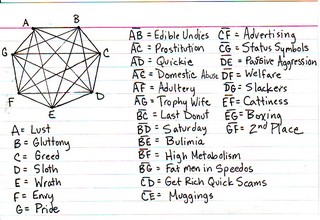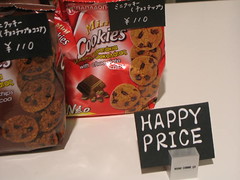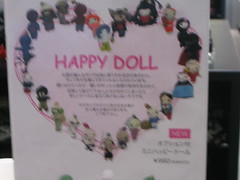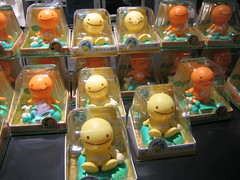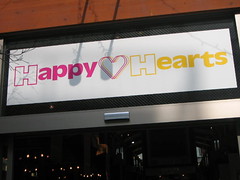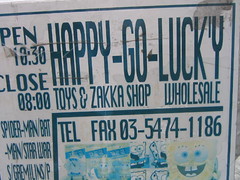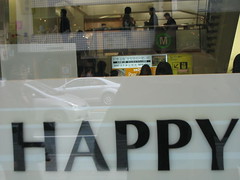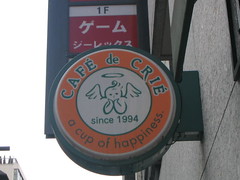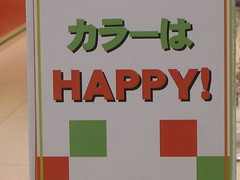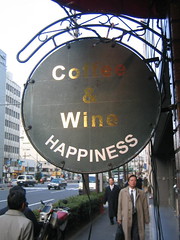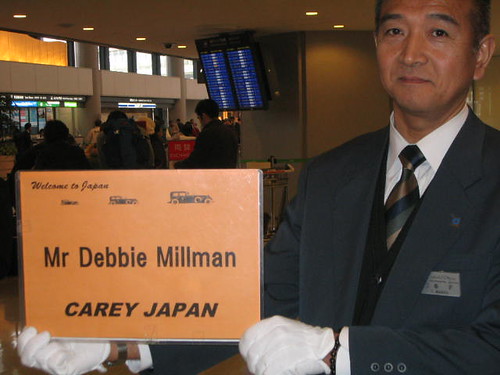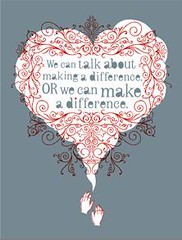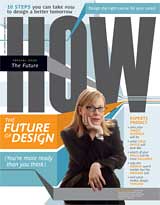Wednesday, February 28, 2007
Sunday, February 25, 2007
Totally Cool Card Catalog Generator
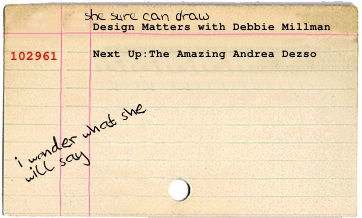
This Card Catalog Generator allows you to create artwork that looks like a vintage index card. You supply the text. Useful for those altered books, designs, or just a fun reference to a bygone tool. Via Threaded Thoughts and Design Your Life.
Thursday, February 22, 2007
Design Matters Live Tonight with Dave Eggers

Adobe and AIGA San Francisco are presenting a very special four-part series—Design Matters Live: Life, Love and the Pursuit of Design. Joining me tonight is Dave Eggers.
Dave Eggers is the author of the memoir A Heartbreaking Work of Staggering Genius (2000), the novels You Shall Know Our Velocity (2002) and What is the What (2006), and the story collection How We Are Hungry (2004). He is editor of the annual The Best American Nonrequired Reading series, and co-editor of the Voice of Witness series of oral histories. In 1998, he founded McSweeney’s, an independent book publishing house in San Francisco which puts out the McSweeney’s quarterly; the monthly magazine The Believer; a daily humor website, www.mcsweeneys.net; and Wholphin, a DVD quarterly of short films. In 2002, he opened 826 Valencia (www.826valencia.org), a writing lab for young people located in the Mission District of San Francisco; there are now branches of 826 in New York, Los Angeles, Seattle, Chicago and Michigan. He has designed most of the books and quarterlies published by McSweeney’s and created the templates for The Believer and Wholphin. His design work has been featured in many annuals and periodicals, and was featured in the National Design Triennial at the Cooper-Hewitt National Design Museum and in the California Design Biennial. Mr. Eggers lives in the San Francisco Bay Area.
This is the agenda:
6:00 - 7:00 pm
Registration, Technology Expo & Reception
7:00 - 7:10 pm
Welcome & Keynote, John Loiacono, Senior Vice President, Creative Solutions Business Unit, Adobe Systems Incorporated
7:10 – 8:00 pm
The Creative Backstory Demo, Colin Fleming, Solutions Engineer, Adobe Systems Incorporated
8:00 – 9:00 PM Design Matters Live
Future Design Matters Lives Events:
Elliott Earls, June 14
Marian Bantjes, September 13
Alan Dye, November 8
Many thanks to ADOBE for making this event possible!
(and to Marian Bantjes for the incredible poster and all graphics)
Wednesday, February 21, 2007
Apples and Oranges. No. Make that Kangaroos.
Jennifer Holliday singing "And I'm Telling You" from the Tony Award winning play Dreamgirls:
Perhaps one of the greatest live performances of our generation.
Jennifer Hudson singing "And I'm Telling You" from the Oscar nominated film Dreamgirls:
Post inspired by the recent discussions on Design Observer.
Perhaps one of the greatest live performances of our generation.
Jennifer Hudson singing "And I'm Telling You" from the Oscar nominated film Dreamgirls:
Post inspired by the recent discussions on Design Observer.
Tuesday, February 20, 2007
Poetry Tuesday: Sound and Vision
This is a beautiful video created by the wonderful artist and designer Petter Ringbom, a partner at Flat. It is for the Swedish singing sensation Tobias Froberg and was shot by Ryan Dunn. Enjoy!
Monday, February 19, 2007
Saturday, February 17, 2007
Friday, February 16, 2007
To Infinity And Beyond
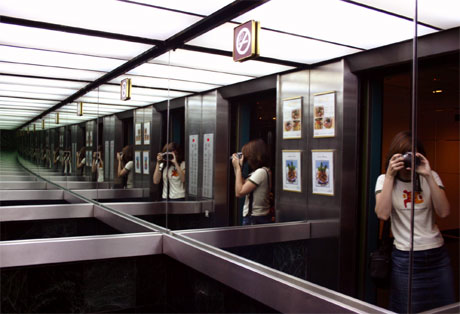
My favorite cookie of all time was a brand made by Keebler named Fudgetown. Fudgetown were chocolate sandwich cookies popular when I was a young girl, and I thought they were the most delectable and beautiful cookies ever created. They were delectable because the milk chocolate was soft and fudgy, and the bisquit was crispy and flaky. They were beautiful because they were shaped liked flowers, with a thick dollop of chocolate deep in the center. I used to savor the experience of these cookies slowly; first I would stick my tongue into the center and flick out the chocolaty dollop, then I would pop open the two sandwich pieces, and use my teeth to scrape off the side with the chocolate. Then I would keep each cookie on my tongue until the heat of my mouth melted it away. This ritual probably took about 20 minutes, but the memory of this experience has lasted a lifetime. And while I also cherished my moments with Wise Bar-b-que Potato Chips, Drakes Yodels and Devil Dogs, Cheese Doodles and Grape Nehi Soda, it is the Fudgetown cookies alone that still make my knees weak with love and devotion.
In addition to the mystical taste these cookies provided, I also fell under the spell of the package containing these blissful morsels. Of course it featured the Keebler Elves, but in as much as I found these brand icons amusing and entertaining, it was not the Elves that captured my interest. What had me utterly mesmerized was what the Elves were doing. What had me positively transfixed was the illustration on the front face panel of the cookie package that featured the Keebler Elves holding a package of Fudgetown cookies. Which meant that the Keebler Elves holding a package of Fudgetown cookies were holding a package featuring the Keebler Elves holding a package of Fudgetown cookies. And so on and so on and so on. The Keebler Elves holding the package of Keebler Elves holding the package was infinite! This killed me! I would stare at the package for hours on end, trying to pinpoint the moment I could see the singularity: where the Keebler Elf and the cookie package both originated. It all ended up in a single point that was indiscernible and I was both entranced and perplexed as to the notion of this infinite lineage. This became my entrée to the concept of infinity, and I found the philosophic conundrum it represented and the unresolved mystery both wondrous and stupefying.
According to David Darling
Yet according to John Barrow, author of The Infinite Book
My search for the origin point on the Fudgetown cookie box was my first experience with the illusory magic of packaging. This obsession boldly grew and came to include Goody Barrette packaging, Golden Book covers, all things Barbie (of course), the record covers of Olivia Newton John, Elton John and later Roger Dean’s covers for the band Yes. Band Aid tins, the Morton Salt girl and McCall Magazine’s Betsy McCall also figured prominently in my attraction to consumer icons. What I now romantically and proudly call branding.
The upside to all of this brand attachment is just that: feeling connected, part of something larger than oneself, and the participation in a real or imagined community of like minded spirits. The downside, of course, is multifaceted. First: these communities may very well have a shaky foundation. After all, it is hard to depend on the reliability and support system of transitional objects, which most of these connections usually are. Second: there comes a point when you realize that these things, these brands, aren’t “enough.” Having more or better or best doesn’t provide you with a lasting sense of having more or being better or being best. It is a rather fleeting experience, this romantic attachment to and with brands, and I find that if I am not careful, the search for having more or better or best is a precarious journey into the infinite. When you depend on finite objects—or brands—to provide you with a long-term sense of self or love or pride or achievement, you set yourself up on a path with no end. No object, no product, and no brand can provide you with ultimate, infinite satisfaction.
I once had a boyfriend tell me I was a bottomless pit of need. He wasn’t saying this because I thought I needed another pair of shoes or a Prada handbag (which I likely did at the time, but that’s another story entirely) but rather because of a fragile emotional state that demanded constant reassurance of my lovability. As you can imagine, this drove him crazy! My infinite need for reassurance required an infinite effort on his part, and you can guess how that relationship ended up. Some infinites are tough. Others, like the idea of infinite space or mathematical subdivisions, are simply inconceivable. But I believe some infinites are worthy challenges: the search for what is truly beautiful: laughing at the same time with someone you love, discovering a perfect piece of poetry, experiencing the deepest feelings of empathy. If that doesn’t work, there are always chocolate cookies, but I do think T. S. Eliot
His soul stretched tight across the skies
That fade behind a city block,
Or trampled by insistent feet
At four and five and six o'clock
And short square fingers stuffing pipes,
And evening newspapers, and eyes
Assured of certain certainties,
The conscience of a blackened street
Impatient to assume the world.
I am moved by fancies that are curled
Around these images, and cling
The notion of some infinitely gentle
Infinitely suffering thing.
Wipe your hand across your mouth, and laugh;
The worlds revolve like ancient women
Gathering fuel in vacant lots.
Design Matters Today with Marty Neumeier
Joining me on todays broadcast of Design Matters is Marty Neumeier.
A designer, writer and former publisher, Marty Neumeier has run his own firm since 1973. After attending Art Center College of Design in Los Angeles, he started Neumeier Design in Santa Barbara, California, and in 1983 opened a second office in Palo Alto to serve clients in the electronics industry. He later combined both offices into a single Silicon Valley operation, which eventually became the leading specialist in retail software packaging. From 1996 to 2001he published Critique, the magazine of graphic design thinking, while continuing to develop packaging and brand icons for Fortune 1000 clients. In 2001 Neumeier relaunched Neumeier Design as Neutron LLC, a pioneer in the field of collaborative brand integration. Neutron is located in San Francisco, California. Over the last thirty years, Neumeier has won hundreds of awards for design and writing, and has become a regular speaker and critic on all matters of design. His book, The Brand Gap is a lively primer on bridging the gulf between strategy and creativity and his latest book Zag, published last Fall, is the ultimate primer on differentiation.
VoiceAmerica is now the industry leader in Internet talk radio, and Design Matters has over 150,000 listeners. We were also voted a "favorite podcast" on IF's Marketing Podcast survey at www.if.psfk.com, and the show is available as Podcasts on iTunes, where over 45,000 people download the show every month. Last week the show was Number 70 in the Top 100 Business podcasts on iTunes as well as a featured podcast on the site.
Design Matters is from 3-4PM EST and you can view the VoiceAmerica Business site and listen to the show from a myriad of locations:
You can go here, through the Sterling link:
http://www.sterlingbrands.com/ListenLive.html
Or you can go here, through the Voice America link:
http://www.modavox.com/VoiceAmericaBusiness/
Or you can go here, through the Designers Who Blog link:
http://www.designers-who-blog.com
Please note that you will need Windows Media Player or the equivalent program to listen in, but you can download the technology for free here:
http://www.microsoft.com/windows/windowsmedia/download/default.asp
Or finally, you can listen to this show, or any of our previous shows, as a Podcast on iTunes, for free. To listen to the Podcasts, you can do either of the following:
Subscribe manually, by going to the iTunes advanced menu, then select "Subscribe to Podcast," then enter the following:
http://www.sterlingbrands.com/DesignMatters/rss.xml as the feed.
Or simply do a search on the iTunes music store Podcast directory for “Design Matters.”
Everyone is welcome to call in live and toll free--the number is 1.866.472.5790.
A designer, writer and former publisher, Marty Neumeier has run his own firm since 1973. After attending Art Center College of Design in Los Angeles, he started Neumeier Design in Santa Barbara, California, and in 1983 opened a second office in Palo Alto to serve clients in the electronics industry. He later combined both offices into a single Silicon Valley operation, which eventually became the leading specialist in retail software packaging. From 1996 to 2001he published Critique, the magazine of graphic design thinking, while continuing to develop packaging and brand icons for Fortune 1000 clients. In 2001 Neumeier relaunched Neumeier Design as Neutron LLC, a pioneer in the field of collaborative brand integration. Neutron is located in San Francisco, California. Over the last thirty years, Neumeier has won hundreds of awards for design and writing, and has become a regular speaker and critic on all matters of design. His book, The Brand Gap is a lively primer on bridging the gulf between strategy and creativity and his latest book Zag, published last Fall, is the ultimate primer on differentiation.
VoiceAmerica is now the industry leader in Internet talk radio, and Design Matters has over 150,000 listeners. We were also voted a "favorite podcast" on IF's Marketing Podcast survey at www.if.psfk.com, and the show is available as Podcasts on iTunes, where over 45,000 people download the show every month. Last week the show was Number 70 in the Top 100 Business podcasts on iTunes as well as a featured podcast on the site.
Design Matters is from 3-4PM EST and you can view the VoiceAmerica Business site and listen to the show from a myriad of locations:
You can go here, through the Sterling link:
http://www.sterlingbrands.com/ListenLive.html
Or you can go here, through the Voice America link:
http://www.modavox.com/VoiceAmericaBusiness/
Or you can go here, through the Designers Who Blog link:
http://www.designers-who-blog.com
Please note that you will need Windows Media Player or the equivalent program to listen in, but you can download the technology for free here:
http://www.microsoft.com/windows/windowsmedia/download/default.asp
Or finally, you can listen to this show, or any of our previous shows, as a Podcast on iTunes, for free. To listen to the Podcasts, you can do either of the following:
Subscribe manually, by going to the iTunes advanced menu, then select "Subscribe to Podcast," then enter the following:
http://www.sterlingbrands.com/DesignMatters/rss.xml as the feed.
Or simply do a search on the iTunes music store Podcast directory for “Design Matters.”
Everyone is welcome to call in live and toll free--the number is 1.866.472.5790.
Wednesday, February 14, 2007
Love Story: Marian Bantjes' Brilliance
I can't possibly say enough about my friend Marian's brilliance. Aside from the fact that I love her madly (which is besides the point, really); I am constantly overwhelmed, impressed, inspired and just plain awed by her talent. Plus she is a kick ass friend, comrade, sister and soul mate.
Five of us at Sterling were lucky enough to be among the 150 people she sent original, hand made Valentines to. This is what mine looks like, followed by what Lisa Grant's looks like.

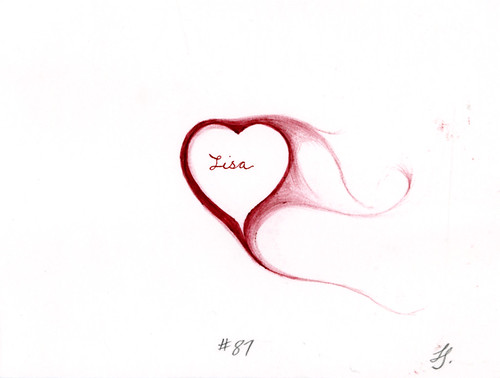
For a peek at all 150 Valentines, here is a link which includes a full description of the daunting endeavor.
And just when you thought Marian couldn't possibly get any more brilliant, here is a link to another project we worked on together.
Happy Valentine's Day!
Five of us at Sterling were lucky enough to be among the 150 people she sent original, hand made Valentines to. This is what mine looks like, followed by what Lisa Grant's looks like.


For a peek at all 150 Valentines, here is a link which includes a full description of the daunting endeavor.
And just when you thought Marian couldn't possibly get any more brilliant, here is a link to another project we worked on together.
Happy Valentine's Day!
Sunday, February 11, 2007
Lost In Translations

I have spent the last week in Tokyo observing Japanese consumers in qualitative market research articulate their feelings and beliefs about mouthwash and potential new package design. It seems absurd, really, to describe my participation as an observer. What I’ve actually been doing is listening to a young female narrator translate into English what these unusually loyal mouthwash users have been saying in Japanese.
Her interpretations have been remarkably creative, offering such statements as “the packaging looks lonely” and “the design is like a fluffy painting” and I have been wondering if her surprising decoding is the verbatim representation of what is being said or the result of an imaginative reconstruction.
I’ll never know. Being in a country where the language and the alphabet are both foreign and unreadable has unabashedly reminded me of my reliance on language and reading in order to communicate and relate. This experience has underscored how dependent I am on the ability to decipher signs in order to distinguish whether where I am headed is joyfully welcoming or dreadfully dangerous, and to reassure me that I know where I am going. This week I have been humbled by my utter lack of both.
I have been thinking about the inadequacy of language and interpretation. What is language, really? Why is it that sounds have come to embody meaning? How accurate are those meanings? These are basic questions of the philosophy of language. And language, like design, is a system of signs used to communicate. The act of communicating is a matter of letting other people know what we think or in many cases, what to think. The signs that make up language get their meaning from our association with them and our collective agreement of these associations.
But John Locke, the great English philosopher, believed that rather than language, thought originates in experience. Out of the product of experience, ideas develop. And through this power of association, ideas are transformed into complex mental constructs like language.
But language is a highly arbitrary and highly interpretive medium. Back when I was about 10 or 11 years old, I went through a particularly difficult phase in my life, wherein my behavior, in reflecting on it now, could probably best be described as post-traumatic stress disorder. As a result of the disruption of my outer world, my inner world began to crumble and I developed a bizarre speech disorder. Whenever anyone asked me how I was doing or what the weather was like or any other rather innocuous question, I froze, and found I couldn’t answer. In as much as I thought I knew how I was doing or what the weather was like, I felt that I couldn’t be absolutely sure. What if my idea about how I was doing wasn’t real? What if the weather was different somewhere else? As I tried to answer these harmless questions, I found that all I could muster were responses such as, “Well, maybe I am feeling well, but maybe I am not” or “Maybe it is raining, but maybe it is not.” “Maybe or maybe not” became my standard reply to any question, including what I wanted for dinner. My mother and stepfather were horrified and angry at my inability to articulate an answer to even the easiest of questions and I was punished for my lack of conviction and clarity. But, for the life of me at the time, I couldn’t fathom how anyone could be sure of anything and I preferred to be grounded than to have to utter a phrase that contained a fixed belief on anything, including even what I wanted for dessert.
Given that language is our primary tool for thinking, can we perceive or describe something without first having a linguistic boundary for it? And where does nuance fit in? What about ambiguity? How can we accurately describe the meaning of the flutter across someone’s face? I think that Mark Rothko described it best as recorded in Bernard Malamud’s heartbreaking introduction to the retrospective tome ‘Mark Rothko.’ Malamud wrote: “Rothko liked to reminisce. One night he told me how he had left his first wife. He had gone off for an army physical during World War II and they had turned him down. When he arrived home and told his wife he was 4-F he didn’t like the look that flitted across her face. The next day he went to see his lawyer about a divorce.”
The French philosopher Jacques Derrida stated that we inhabit "a world of signs without fault, without truth and without origin". One of the central tenets of his philosophy (also called Deconstructivism) is ‘there is nothing outside the text.’ Deconstructionism is aptly named because it seeks to deconstruct the nature and meaning of language. Common phases reflecting this ideology include, "We really can’t know if something is true or not" or my favorite: "That depends on what the meaning of ‘is’ is."
Critics of Derrida complain that if words have no meaning, there is no meaning. Or, if there is, you cannot actually communicate it. I fundamentally disagree. Design is first and foremost a language that dependent on words in order to communicate. Like the facial flutter of Rothko’s ex-wife proves, symbols and action have as much profundity as words. In fact, facial gestures are all but universal and far more trustworthy in reading a situation than language could hope to be.
Nevertheless, language can be helpful. Yesterday, in hiring a taxi to transport me from the middle of Tokyo back to my hotel, I found that the elderly taxi driver had no idea what I was saying and where I was asking him to go. As my attempts to communicate proved fruitless, I began to ask passersby if they could help me. A young Japanese woman came over and I asked her if she could help me tell the cab driver where I was going, as I was lost. It seemed that she understood the word “lost” and I began to feel relived. But before I knew it, she got into the cab along side me and started feeling around the floor! She falteringly asked me “What lost?” but before I could answer, she motioned to other passersby. Suddenly five generous people began looking for something I hadn’t lost in and around the taxi. I couldn’t help but laugh and consider the various things one actually could lose: your confidence, your control, your appetite, your dignity, your reputation, your keys, your dog, your faith, your shirt, your heart, your mind, your life. I had simply lost my way. It took a few minutes, but I was finally able to correct the miscommunication by showing the growing group around me a postcard of the hotel where I was staying, which fortuitously, I remembered I had in my handbag. The image did the trick, and then all of us: the young woman, the elderly cab driver, the burgeoning crowd of helpers and me, all bust into spontaneous clapping and laughing. Not a word was uttered, not a phrase was exchanged, but suddenly, everyone was on exactly the same page, and everyone understood.
Saturday, February 10, 2007
Friday, February 09, 2007
Thursday, February 08, 2007
Wednesday, February 07, 2007
Saturday, February 03, 2007
Friday, February 02, 2007
Design Matters Today with Doyald Young
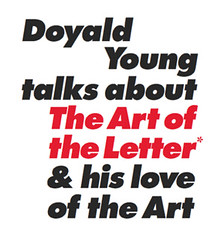
Joining me on todays broadcast of Design Matters is DOYALD YOUNG.
Since 1955, Doyald Young has specialized in the design of logotypes, corporate alphabets, and typefaces. He has designed logotypes and trademarks for the industrial design firm of Henry Dreyfuss Associates, California Institute of Technology, University of California at Los Angeles, exhibition catalogs for UCLA’s Clark Memorial Library, The Music Center of Los Angeles County, Mattel Toys, Max Factor, and Vidal Sassoon, and the Prudential Insurance Company of America. With Don Bartels, Mr. Young designed the GE Logo Font for General Electric Company’s corporate identity program. As an associate of International Design Associates of Japan, designed logotypes for over a dozen hotels, including restaurants, bars and amenities: ANA Hotel Tokyo, Hilton International Japan, Tokyo Hilton, Hilton Osaka, Narita Golf Club, Pacific Star Hotel, Guam, Palace Hotel Tokyo, and the 30-story Kintetsu Hotel at Universal City Osaka, and designed The Hawaiian Sony Open logo for Mari Makinami, Design Resource.
His entertainment credits include: Liza Minnelli and Frank Sinatra specials, Disney’s 30th Anniversary Celebration, Harry Connick Jr., k.d. lang, Bette Midler, Prince, The Grand Reopening of Carnegie Hall, The Grammy Awards, The Annual Academy of Country Music Awards, The Golden Globe Awards, The Tony Awards, and the Art Directors Guild logo.
Mr. Young has served as a consultant to Xerox Corporation, Southern California Edison Company, and Bechtel Corporation, designed fonts for Esselte Letraset, Agfa Corporation, Visual Graphics Corporation, and he consulted with Emerson Stern and the Salk Institute on the development of a written American Sign Language alphabet for The National Institutes of Health. For Faidon Design of Gotenberg Sweden, Mr. Young collaborated on the design of Vestia, a securities organization. He is a member of AIGA, and currently teaches lettering and logo design at Art Center College of Design, where he taught lettering, logo design, and typographic basics from 1955 to 1978, then again from 1998. In 2001 Art Center College of Design named him Inaugural Master of the School for teaching and his contribution to the field of art and design.
Mr. Young is the author of Logotypes & Letterforms, Handlettered Logotypes and Typographic Considerations, Fonts and Logos, that addresses basic letter and font structure, typography, and logo design, and The Art of the Letter, published by SMART Papers.
The typefaces designed by Doyald Young include Young Baroque, ITC Eclat and Home Run.
VoiceAmerica is now the industry leader in Internet talk radio, and Design Matters has over 150,000 listeners. We were also voted a "favorite podcast" on IF's Marketing Podcast survey at www.if.psfk.com, and the show is available as Podcasts on iTunes, where over 45,000 people download the show every month. Last week the show was Number 77 in the Top 100 Business podcasts on iTunes as well as a featured podcast on the site.
Design Matters is from 3-4PM EST and you can view the VoiceAmerica Business site and listen to the show from a myriad of locations:
You can go here, through the Sterling link:
http://www.sterlingbrands.com/ListenLive.html
Or you can go here, through the Voice America link:
http://www.modavox.com/VoiceAmericaBusiness/
Or you can go here, through the Designers Who Blog link:
http://www.designers-who-blog.com
Please note that you will need Windows Media Player or the equivalent program to listen in, but you can download the technology for free here:
http://www.microsoft.com/windows/windowsmedia/download/default.asp
Or finally, you can listen to this show, or any of our previous shows, as a Podcast on iTunes, for free. To listen to the Podcasts, you can do either of the following:
Subscribe manually, by going to the iTunes advanced menu, then select "Subscribe to Podcast," then enter the following:
http://www.sterlingbrands.com/DesignMatters/rss.xml as the feed.
Or simply do a search on the iTunes music store Podcast directory for “Design Matters.”
Everyone is welcome to call in live and toll free--the number is 1.866.472.5790.


